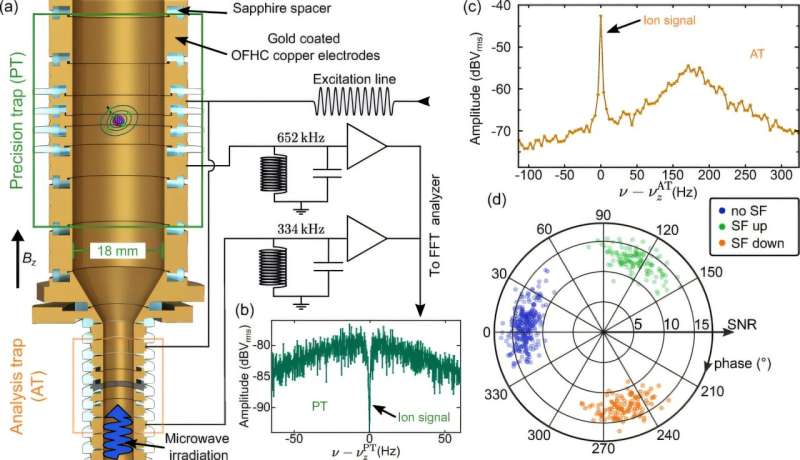Highly charged heavy ions form a very suitable experimental field for investigating quantum electrodynamics (QED), the best-tested theory in physics describing all electrical and magnetic interactions of light and matter. A crucial property of the electron within QED is the so-called g factor, which precisely characterizes how the particle behaves in a magnetic field.
Recently, the ALPHATRAP group led by Sven Sturm in the division of Klaus Blaum at the Max-Planck-Institut für Kernphysik (MPIK) in Heidelberg measured the g factor of hydrogen-like tin ions on a precision level of 0.5 parts per billion, which is like measuring the distance from Cologne to Frankfurt with precision down to the thickness of a human hair. This is a stringent test of QED for the simplest atomic system, just like conventional hydrogen but with a much higher electric field experienced by the electron due to the charge of 50 protons inside the tin nucleus.
In a new study published in Physical Review Letters, researchers have now tackled highly charged boron-like tin ions with only five remaining electrons. The goal is to study the inter-electronic effects in the boron-like configuration. So far, the only boron-like g factor has been measured with high precision for argon ions with a proton number Z of 18. However, the nucleus is not a point charge like the electron and its charge distribution leads to finite nuclear size corrections—another challenge for precision experiments.
For the measurement, a 118Sn45+ ion was stored in the ALPHATRAP ion trap. “Due to the long storage time of about 40 days, we are able to measure the g factor with unprecedented precision,” says postdoc Jonathan Morgner. “By combining the new result with already existing data for hydrogen-like tin, we can cancel out the finite nuclear size corrections.” The new result for the g factor of 118Sn45+ is 0.644 703 826 5(4) with the uncertainty given in brackets.

To compare with the experimental value, physicists in the theoretical division of Christoph Keitel at MPIK calculated the g factor of 118Sn45+. “Our well-developed ab initio QED approach also takes into account the effects of electron correlation as well as the finite nuclear size,” explains Matteo Moretti.
For the finite nuclear size corrections, there is an intrinsic cancelation near Z = 54 which makes this uncertainty intrinsically small in tin with Z = 50. The theoretical prediction for the g factor of 0.644 702 9(8) is consistent with the experimental value.
The experiment, being about a factor of 2000 more precise than the theoretical prediction, is a benchmark for future advances in atomic QED. As a crucial data-point for boron-like systems at intermediate nuclear masses, it demonstrates the potential of a competitive determination of the fine structure constant α, a fundamental quantity that governs the strength of electromagnetic forces throughout the whole universe.
The optimal for future experiments is boron-like xenon (Z = 54), for which the finite nuclear size corrections are expected to be minimal. On the theoretical side, the future challenge is to improve calculations necessary to match the experimental precision.
More information:
J. Morgner et al, g Factor of Boronlike Tin, Physical Review Letters (2025). DOI: 10.1103/PhysRevLett.134.123201
Citation:
A new benchmark for quantum electrodynamics in atoms: Precision measurement of boron-like tin ion’s g factor (2025, March 26)
retrieved 26 March 2025
from
This document is subject to copyright. Apart from any fair dealing for the purpose of private study or research, no
part may be reproduced without the written permission. The content is provided for information purposes only.

